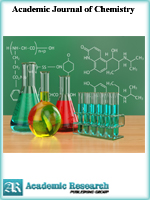Academic Journal of Chemistry
Online ISSN: 2519-7045
Print ISSN: 2521-0211
Print ISSN: 2521-0211
Quarterly Published (4 Issues Per Year)

Archives
Volume 1 Number 1 October 2016
Rapid Access to Synthesis of Bisindole Derivatives Using 2-Morpholino Ethanesulphonic Acid
Authors: Rajendra P. Pawar ; Devidas S. Bhagat ; Suresh U. Shisodia ; Hanuman D. Bhosale ; Sudam S. Pandule ; Pravin S. Kendrekar
Pages: 26-32
Abstract
The present work demonstrates easy and effective synthesis methodology for synthesis of bisindole derivatives in presence of protic organic acid 2-morpholino ethanesulphonic acid (MESA). 2-MESA is water soluble catalyst easy to extract and work-up for the synthesis of bisindole class of compounds. Catalyst is recovered and recycled by simple evaporation of water. Efficient aromatic electrophilic substitution of indoles (2 mmol) with aromatic aldehydes (1 mmol) equipped with various constituents were carried out employing a catalytic amount in ethanol to obtain bisindoles in good to excellent yields.
Effects of Green Tea Extracts on the Oxidation Stability of Olive and Melon Seed Oils
Authors: Maduelosi, N. J. ; Angaye, S. S.
Pages: 22-25
Abstract
The present study is aimed at exploring singlet oxygen quenching ability of methanolic extract of green tea in methylene-blue sensitized photo-oxidation of olive and melon seed oils. Purified and oven-dried samples of melon seed oil and Goya brand olive oil as obtained from the manufacturer were used for the study. In this research, the effects of methanolic extracts of green tea as an antioxidant on the oxidative stability of olive and melon seeds oils were studied. The oil samples were subjected to methylene blue sensitized photoxidation in 10% methanol in dichloromethane for a duration of 10 hours with and without added green tea extract. The oxidized oil samples were analyzed for the following parameters: peroxide value, iodine value and % free fatty acid value. The results of the study suggest that green tea extract exhibit singlet oxygen quenching ability under sensitized photoxidation, which is dose dependent for both oils under the experimental conditions.
Corrosion in Mild Steel Prevention by Vapor Phase Process as Plasma Impulse (Anthracene Metadinitro Benzene and Naphthalein)
Authors: Shailendra Kumar Dwivedi ; Rajendra Kumar
Pages: 13-21
Abstract
It is the process of prevention of corrosion of mild steel from vapors emitted by packing woods. It was observed that the passive film on mild steel surface has been presented. The passive film is stabilized by continued exposure to the passivating environment The vapor of anthrocene and naphthalene some other related substances are deposited over the surface of mild steel .This is vapours phase process damage of various electronic equipments due to corrosion small assemblies and big boilers are corroded coating is affected but a very small range big range of protection is only vapour phase process like diposition of plasma material at the surface of mild steel these are vapour emitting substance reach where coating is not possible plasma pulse are important in growth of thin film over the surface.
Preparation of Y-Alumina from Kankara Kaolin in Nigeria by Acid Leaching Using Hydrochloric Acid
Authors: A. Aliyu ; U. Ahmadu ; A. A. Abdelmalik ; U. Sadiq
Pages: 8-12
Abstract
Investigation has been done concerning Kaolin based alumina prepared by acid leaching method. This was initially fired at 600℃ for 4 hours to increase its reactivity. For better yield Hydrochloric Acid ( HCl) was used for the digestion as against the conventional Sulphuric acid (H2SO4). The gelatinous precipitate of the hydrated alumina was further filtered under vacuum 400°C for 2h, which resulted the formation of γ-alumina. The structure of γ-alumina was confirmed by XRD and its corresponding diffractogram parameters and SEM and the mean particles size of γ-alumina was determined by SEM to be 3 - 9 μm.. Foamy agglomerates at low magnification and the presence of larger voids in theirs structures at high magnification were visible from the SEM images. The study revealed that kaolin could be promising material for preparation of γ-alumina
Synthesis, Characterization and Antimicrobial Activities of Mixed Ligand Divalent Metal Complexes of N-Phenyl Dithiocarbamate with Alanine - Schiff Base
Authors: Ejelonu B. C. ; Olagboye S. A. ; Olawade D. B. ; Ekpo I. S.
Pages: 1-7
Abstract
Synthesis, characterization and antimicrobial activities of mixed ligand metal complexes of N-Phenyl dithiocarbamate with schiff base of Mn(II), Fe(II), and Pb(II),Co(II),Ni (II),Cu (II),Zn(II) and Cd (II) metal ions were carried out in this study. The ligands and their respective metal complexes were characterized by FTIR, UV spectroscopy, and elemental analysis. The data from the elemental analysis suggest a good agreement between the calculated and the experimental values for the elements viz; C, H, N and S. Also, the UV-Visible and FTIR spectroscopic data revealed that the metal complexes coordinate through the nitrogen and oxygen atoms of the alanine Schiff base and via the two sulphur atoms of the N-Phenyl dithiocarbamate ligands which serve as bidentate sites for the ligand.The antimicrobial l studies revealed that the synthesized ligands and their metal complexes recorded strong potency against the pathogens being investigated, suggesting that they could serve as good antimicrobial agents against the selected pathogens.



